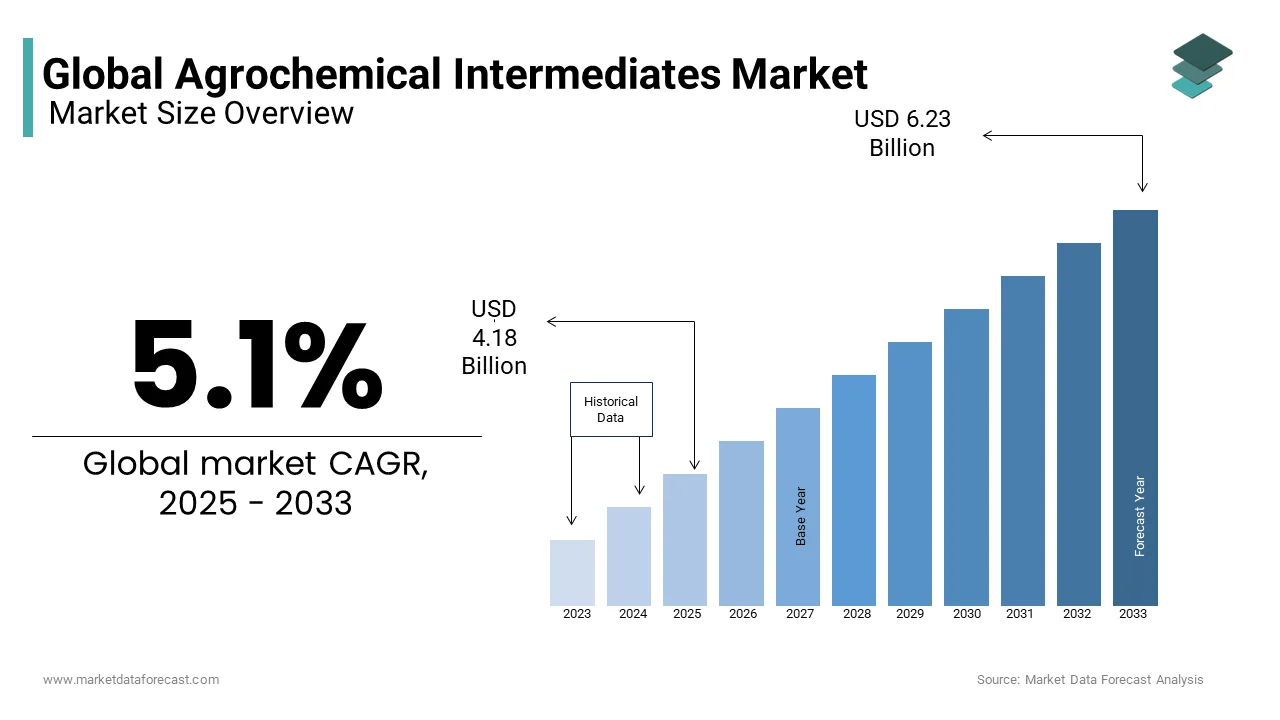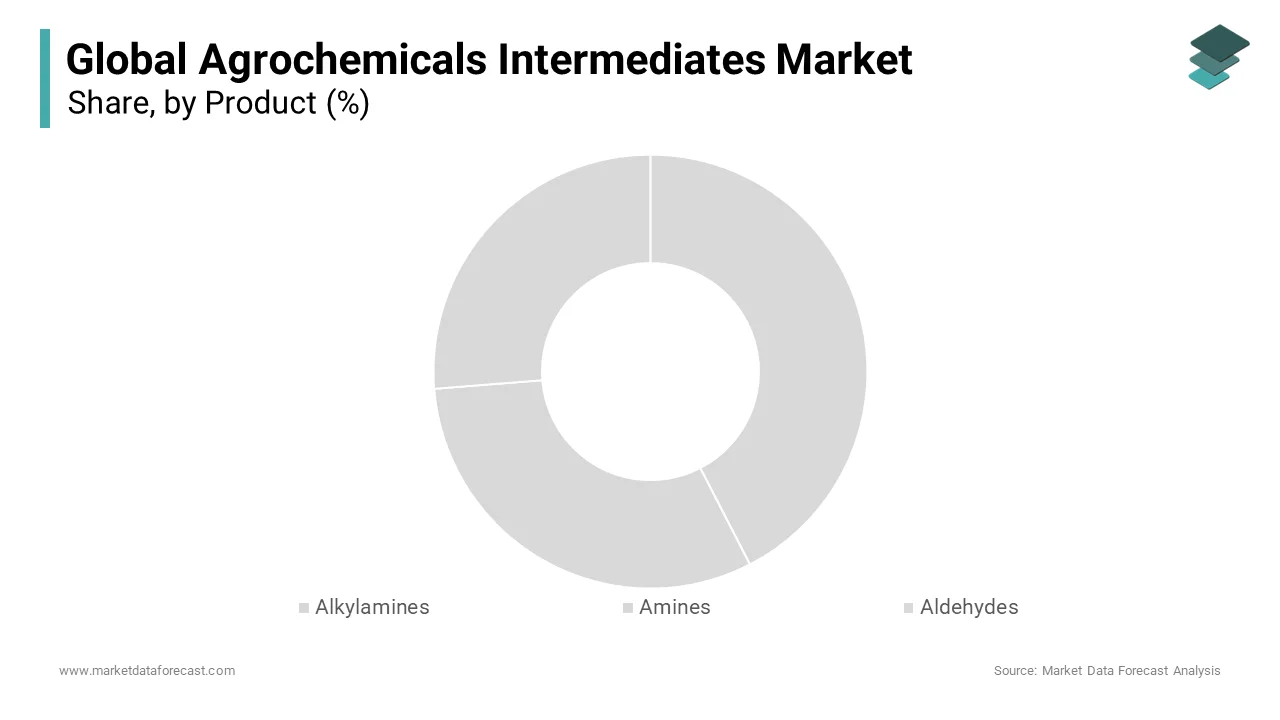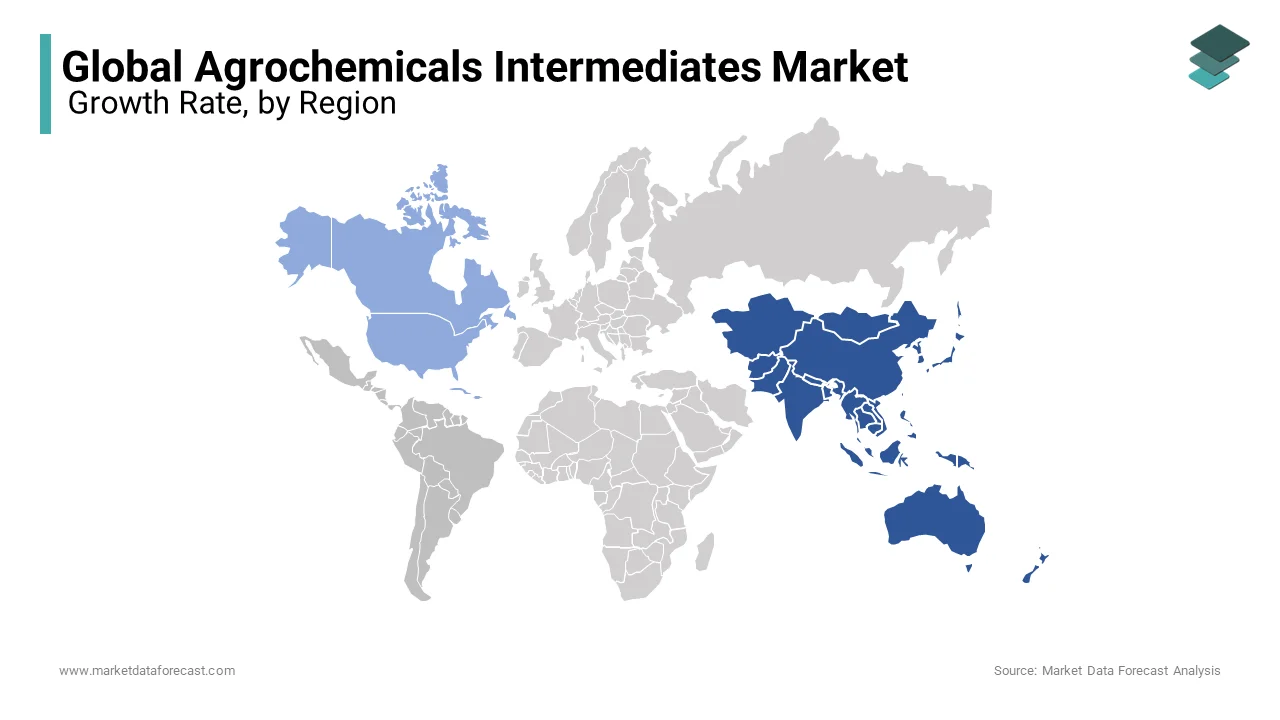Global Agrochemical Intermediates Market Size, Share, Trends, And Growth Forecasts Report - Segmented By Product (Alkyl Amines, Amines, Aldehydes, And Acids), Type (Insecticides, Herbicides And Fungicides), By Region (North America, Latin America, Asia Pacific, Europe, Middle East and Africa) - Industry Analysis From 2025 to 2033
Global Agrochemical Intermediates Market Size
The global agrochemical intermediates market was valued at USD 3.98 billion in 2024 and is anticipated to reach USD 4.18 billion in 2025 from USD 6.23 billion by 2033, growing at a CAGR of 5.1% during the forecast period from 2025 to 2033.

CURRENT SCENARIO OF THE GLOBAL AGRICULTURE INTERMEDIATES MARKET
Agrochemical Intermediates are widely used to manufacture pesticides such as insecticides, herbicides, and fungicides. Common examples of agrochemical intermediates are 2-chloro-5-chloro Methyl Pyridine, Diethyl Phosphorochloridothionate, 2-Chloropropionic Acid, 4-fluorotoluene and 2-Chloro-6-(Trichloromethyl) Pyridine. The agrochemical intermediates act as the building blocks for the production of final products. The global agrochemical intermediates market has accounted for considerable growth in the past years and is anticipated to record substantial growth during the forecast period. These enhance the crop yield and protect the crop from insects and pests, which is driving the market growth rate. With a growing world population, emerging environmental concerns, and unforgiving climate changes the agricultural industry is being challenged to develop innovative and targeted solutions to help ensure the success of crops, livestock, and the land itself. To meet these demands, several additives derived from agricultural intermediates are thrown into the fray.
- According to a UN report, the projected rise in food demand by 2050 ranges from 59% to 98% due to the increasing population rate.
MARKET DRIVERS
The growth of the agrochemical intermediates market is mainly driven by the increasing global population. As the population continues to boom, more pressure is being put on the farmers to produce more per hectare. This promotes the use of chemical substances to boost productivity and minimize crop loss to the elements and pests. The favorable government policies and technological advancements are further boosters for market growth. The escalating demand for food owing to the increasing global population is making farmers and agricultural producers adopt agrochemical intermediates for enhancing crop productivity, which drives market growth.
- For Instance, the latest estimate from the UN states that there are 7.3 billion people, and it is projected to increase to 9.7 billion by 2050.
The developing nations and rising disposable incomes of the people, growing awareness among agricultural producers regarding the necessity of agrochemicals are propelling the market growth rate. The rising investments by the significant market players in research activities to enhance the efficacy of the products, along with safety to human health and the environment, are estimated to augment the market growth opportunities in the coming years. Various benefits of agrochemicals, such as maximizing crop production, providing essential nutrients, and protecting the crop from pests and insects, which leads to food security; these factors are gaining traction among the people, leading to substantial market growth. Agrochemicals help farmers to produce high productivity with less land area by providing essential supplements to the plants along with protection, proliferating the market growth rate. The growing export and import of agrochemicals from developing nations are estimated to contribute to the growth of global market revenue.
- According to data provided by the World Trade Organization (WTO), in 2024, India held the position of second-largest exporter of agrochemicals worldwide. The country’s agrochemical exports are valued at USD 5.5 billion, whereas the U.S stands at USD 5.4 billion.
MARKET RESTRAINTS
The high cost associated with the agrochemical intermediates is a significant factor in restraining market growth. The rising environmental concerns regarding air and water pollution and the causes of soil degradation, which affects human health, hamper the market growth rate. Agrochemicals negatively impact the ecosystem as they reduce biodiversity and harm aquatic life, which is raising concerns among the people, leading to limited market growth. Another factor restraining the market growth is the chance of nutrient imbalance, where the excessive use of agrochemicals can generate residues, causing nutrient imbalance and leading to a reduction in the quality of agricultural productivity. The agrochemicals may harm the non-target organisms, which may negatively impact crop productivity and quality, thus impeding market expansion. The high costs of research and development of new moieties, especially in developing nations, along with high specifications, may restrict the market growth.
MARKET OPPORTUNITIES
The increasing adoption of modern farming technologies is a significant factor providing growth opportunities to the agrochemical intermediates market growth. Agrochemical intermediates such as insecticides, fungicides, and herbicides play a crucial role in enhancing crop productivity and securing crops from pests. The rising technical advancements will increase agricultural operations, efficiency, and the safety of crops, which will positively influence global market expansion. The escalation in precision agriculture and the utilization of modern machinery in agriculture are accelerating growth opportunities. The agrochemical intermediates help by supplying the necessary basic materials for advanced agrochemicals, which proliferate crop productivity, leading to substantial market growth.
- For Instance, the planted area for crops increased by 14% compared to last year, and the harvested area for grain increased by 34% in the United States. The rising adoption of modern farming technologies is escalating crop production.
MARKET CHALLENGES
The stringent regulations regarding product approvals and the complexity of regulatory authorities, along with higher standards for safety and efficacy, will act as significant challenges to the market players in expanding the market growth. The availability of various other alternatives for pest control and to enhance crop productivity may hinder the adoption of agrochemical intermediates, leading to limited market growth. Due to the presence of high chemical content, the utilization of agrochemical intermediates may lead to food safety issues for humans, which acts as a challenge to market growth.
REPORT COVERAGE
|
REPORT METRIC |
DETAILS |
|
Market Size Available |
2024 to 2033 |
|
Base Year |
2024 |
|
Forecast Period |
2025 to 2033 |
|
CAGR |
5.1% |
|
Segments Covered |
By Product, Type, and Region |
|
Various Analyses Covered |
Global, Regional & Country Level Analysis, Segment-Level Analysis, DROC, PESTLE Analysis, Porter’s Five Forces Analysis, Competitive Landscape, Analyst Overview of Investment Opportunities |
|
Regions Covered |
North America, Europe, APAC, Latin America, Middle East & Africa |
|
Market Leaders Profiled |
RohnerChem, Eastman, Arkema, AGC, Lonza, Sugai Chemical, Kuraray, BASF, Evonik, Air Water, Astec, WeylChem Group, DPx Fine Chemicals, Mitsubishi Corporation, and Sudarshan Chemical and Others. |
SEGMENT ANALYSIS
Global Agrochemical Intermediates Market Analysis Analysis By Product
The aldehyde segment dominated the global agrochemical intermediates market revenue and is expected to maintain the domination during the forecast period. The aldehydes act as necessary starting material for the production of various types of pesticides, herbicides, and fungicides, which drives the segment growth rate. The aldehydes enhance the agricultural output owing to the increased food security and increased global population which propels the segment revenue.

The amines segment is estimated to grow notably in the coming years with rapid growth rate. The amines act as the fundamental building blocks in the production of herbicides, fungicides, and pesticides, which augments the segment growth. The chemical adaptability and reactions of amines help in the creation of diverse agrochemicals, leading to innovations and providing market growth opportunities.
Global Agrochemical Intermediates Market Analysis Analysis By Type
The herbicides segment held the most significant share in the global agrochemicals intermediates market revenue and is predicted to record substantial growth in the coming years. Herbicides are a significant product that helps control weed populations, leading to higher crop yields and assured quality, which drives the segment growth rate. The increasing adoption of efficient agricultural practices among farmers to meet the food demand of the global population and the escalating technological advancements are propelling the segment's growth.
- For Instance, the worldwide agricultural use of herbicides is around 2.3 million metric tons in 2024 and is estimated to have a volume of around 2.4 million metric tons by 2033.
The insecticides segment is projected to register a rapid growth rate during the forecast period. Insecticides are widely adopted in agricultural practices to eliminate the insects and pests that impact negatively on crop yield. This is augmenting the global market growth.
REGIONAL ANALYSIS
The Asia Pacific region accounted for the most significant share in the agrochemical intermediates market and is projected to have notable growth during the forecast period. The increased regional population, growing agricultural practices, and expanding adoption of advancements in the agricultural industry across India and China are contributing to the regional market share growth. The growing demand for the food is enhancing the requirement of higher crop yields which fuels the expansion of the regional market revenue.

- For Instance, by 2055, the Asia Pacific region’s population is estimated to reach 5.25 billion, accounting for approximately 54% of the global population.
The North American region is anticipated to have notable growth with considerable CAGR during the forecast period. The presence of a well-established agricultural industry, the rising utilization of agrochemical intermediates for better crop yield, and the growing technological advancements are propelling the regional market share growth. The supportive regulatory framework, along with growing government initiatives, is expected to enhance the market growth opportunities in the coming years.
- In 2024, Cargill announced its support to farmers in the implementation of procedures and systems fundamental to regenerative agricultural practices. This initiative is estimated to cover 10 million farmland in North America over 10 years.
The European region is expected to register considerable growth during the forecast period owing to its expanding agricultural production and advanced farming technologies. The growing initiatives by the regional authorities in the extension of agricultural production drive the regional market growth.
RECENT HAPPENINGS IN THIS MARKET
- In February 2024, Corteva, a multinational corporation, announced the introduction of two new crop protection products. One product is the herbicide Gapper, which is developed to manage weed growth in maize and soybean fields, and another one is the herbicide Elevore, which was specifically developed to desiccate soybean plants during sowing.
- In April 2024, Atul, Ltd., a chemical business, announced the introduction of its own formulation, Sindica, which is an herbicide applied after weed emergence and is specifically targeted for the most significant weeds affecting sugarcane crops.
- In March 2024, Sipcam Oxon SpA, a prominent producer of agricultural technology, declared the acquisition of Phyteurop SA through its subsidiary Sipcam French SA.
KEY MARKET PLAYERS
RohnerChem, Eastman, Arkema, AGC, Lonza, Sugai Chemical, Kuraray, BASF, Evonik, Air Water, Astec, WeylChem Group, DPx Fine Chemicals, Mitsubishi Corporation, and Sudarshan Chemical and Others. These are the market players that are dominating the global agrochemicals intermediate market.
MARKET SEGMENTATION
This research report on the global agrochemical intermediates market is segmented and sub-segmented based on product, Type, and Region.
By Product:
- Alkylamines
- Amines
- Aldehydes
- Acids
By Type:
- Insecticides
- Herbicides
- Fungicides
By Region
- North America
- Europe
- Asia-Pacific
- Latin America
- Middle East and Africa
Frequently Asked Questions
What is the current market size of the global agrochemical intermediates market?
The current market size of the global agrochemical intermediates market was valued at USD 4.18 billion in 2025
Who are the market drivers that are driving the global agrochemical intermediates market?
The developing nations and, rising disposable incomes of the people, growing awareness among agricultural producers regarding the necessity of agrochemicals are propelling the market growth rate.
What are the market opportunities in the global agrochemical intermediates market?
The increasing adoption of modern farming technologies is a significant factor providing growth opportunities to the agrochemical intermediates market growth.
Who are the market players that are dominating the agrochemicals intermediates market?
RohnerChem, Eastman, Arkema, AGC, Lonza, Sugai Chemical, Kuraray, BASF, Evonik, Air Water, Astec, WeylChem Group, DPx Fine Chemicals, Mitsubishi Corporation, and Sudarshan Chemical and Others.
Access the study in MULTIPLE FORMATS
Purchase options starting from
$ 2500
Didn’t find what you’re looking for?
TALK TO OUR ANALYST TEAM
Need something within your budget?
NO WORRIES! WE GOT YOU COVERED!
Call us on: +1 888 702 9696 (U.S Toll Free)
Write to us: sales@marketdataforecast.com